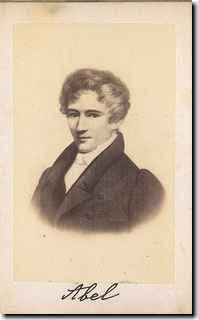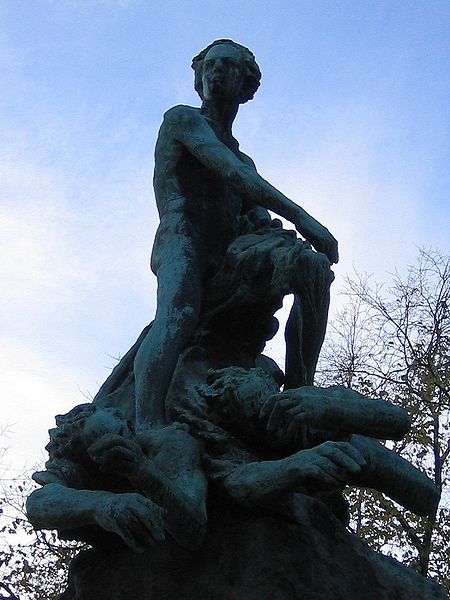<Back to Index>
- Mathematician Niels Henrik Abel, 1802
- Novelist Henri René Albert Guy de Maupassant, 1850
- 1st President of the Republic of Brazil Manuel Deodoro da Fonseca, 1827


Niels Henrik Abel (August 5, 1802 – April 6, 1829) was a noted Norwegian mathematician who proved the impossibility of solving the quintic equationin radicals.
Abel was born in Nedstrand, Norway, as second child to Søren Georg Abel and Anne Marie Simonsen. When he was born the family lived at the rectory at Finnøy.
Much suggests that Niels Henrik was born in the neighboring parish, as
their parents were guests at the bailiff in Nedstrand in July / August
of his year of birth. Abel's father, Søren Georg Abel, had a degree in theology and philosophy and served as pastor at Finnøy. Abel's grandfather, Hans Mathias Abel, was pastor at Gjerstad near Risør.
After the latter's death, in 1804, Søren Georg Abel was
appointed pastor at Gjerstad and the family moved there. Søren
Georg Abel spent his childhood, and had also served as chaplain, at
Gjerstad. Anne Marie Simonsen was from Risør and her father,
Niels Henrik Saxild Simonsen, was a tradesman and merchant ship-owner.
He was said to be the richest person in Risør. Anne Marie had
grown up with two step-mothers, in relative luxurious surroundings. At
Gjerstad rectory she enjoyed arranging balls and social gatherings.
Much suggests she was early on an alcoholic and took little interest in
the upbringing of the children. Niels
Henrik and his brothers were lectured by their father, with handwritten
books to read. Interestingly, a subtraction table in a book of
mathematics reads 1-0=0.
With the independence and first election of Norway in 1814, Abel's father was voted in as a representative to the Storting. Meetings of the Storting were until 1866 held in the main hall of the Cathedral School in Christiania (now
known as Oslo). Most certainly this is how he got in contact with the
school, and decided his eldest son, Hans Mathias, was to start next
year. When the time for departure approached, the boy was so saddened
and depressed over having to leave home, that his father did not dare
send him away. He decided to send Niels Henrik instead. In 1815, Abel entered the Cathedral School,
aged 13. Hans Mathias Abel, joined him the next year. They shared
apartment and had classes together. His brother did, in general, get
better grades than Niels Henrik Abel. A new mathematics teacher, Bernt Michael Holmboe,
was appointed in 1818. He gave the students mathematical tasks to do at
home. Seeing Abel's talent in mathematics he encouraged him to study
the subject to an advanced level. He also gave Abel private lectures
after school. In 1818 Abel's father had a public theological argument with Stener Johannes Stenersen regarding
Abel's catechism from 1806. The argument was well covered in press and
Abel was not doing well. He was given the nickname "Abel
Treating" (Norwegian: "Abel Spandabel"). Niels Henrik Abel's
reaction to the quarrel was said to be "excessive gaiety". At the same
time Abel's father almost faced impeachment after insulting Carsten Anker, the host of the Norwegian Constituent Assembly.
In September 1818, he returned to Gjerstad with his political career in
ruins. He began drinking heavily. Abel's father died in 1820, aged 48.
In his funeral, with the rectory full of guests, widowed Anne Marie
Abel, got drunk and went openly to bed with one of the servants. The
two brothers reacted differently to the decline of the family. At
school, Niels Henrik did extremely well in mathematics, however he was
struggling in other subjects. Hans Mathias went into a serious
depression, never to recover. Hans Mathias quit school and returned to
Gjerstad shortly before their father died. The family was left in
strained circumstances. Anne Marie Abel's once rich father, had also
faced decline. He went bankrupt in a recession after the Napoleonic Wars, and died also in 1820. Holmboe supported Abel with a scholarship to remain at school and raised money from his friends to enable Abel to study at the Royal Frederick University. Abel
entered the university in 1821. He was already the most knowledgeable
mathematician in Norway. Holmboe had nothing more he could teach him
and Abel had studied all the latest mathematical literature in the
University library. Abel had also started work on his first
achievement, the quintic equation in
radicals. Abel initially thought he had found the solution to the
quintic equation in radicals in 1821. Mathematicians had been looking
for a solution on this problem for over 250 years. The two professors
in Christiania, Søren Rasmussen and Christopher Hansteen, found no errors in Abel's formulas, and sent the work on to the leading mathematician in the Nordic countries, Professor Ferdinand Degen in
Copenhagen. He also found no faults, but still doubted that the
solution that so many outstanding mathematicians had sought after, now
really should have been found by an unknown student in the distant
Christiania. Degen noted however Abel's unusual sharp mind and
believed that such a talented young man should not use its powers in
such a "sterile object" as the fifth degree equation, but rather on Elliptic Functions and Transcendence, for then, writes Degen, he will "discover Magellanian thoroughfares to large portions of a vast analytical ocean". Degen
asked Abel to give a numerical example of his method and, while trying
to provide an example, Abel discovered a mistake in his paper. Abel graduated in 1822. His performance was medium, except in mathematics. After
he graduated, professors from university supported him financially and
professor Christopher Hansteen let him live in a room in the attic of
his home. He was later to view Ms. Hansteen as his second mother. While
living here, Niels Henrik Abel helped a younger brother, Peder Abel,
through to examen artium.
He also helped a sister, Elisabeth, to find work in town. In spring 1823
Abel published his first article in "Magazin for Naturvidenskaberne",
Norway's first journal on sciences and co-founded by professor
Hansteen. He published a few articles, but the journal soon understood
that this was not material for the common reader. In 1823 he also wrote
a paper in French. It was "a general representation of the possibility
to integrate all differential formulas". He applied for funds at the university to publish it, however the work was lost, never to be refound, while being reviewed. In summer 1823 professor Rasmussen gave Abel a gift of 100 speciedaler so he could travel to Copenhagen and visit Ferdinand Degen and other mathematicians there. While there he did some work on Fermat's Last Theorem. Abel's uncle, Peder Mandrup Tuxen, lived at the naval base in Christianshavn, Copenhagen. At a ball there, he met Christine Kemp, his future fiancee. She moved in 1824 to Son, Norway to work as governess. They got engaged Christmas 1824. After
returning from Copenhagen, Abel applied for a government scholarship in
order to visit top mathematicians in Germany and France. Instead, he
was granted 200 speciedaler yearly for two years, to stay in Cristiania
and learn German and French. The next two years he was promised a
scholarship of 600 speciedaler yearly and he would then be permitted to
travel abroad. While
learning languages, Abel published his first notable work in 1824,
Mémoire sur les équations algébriques où on
démontre l'impossibilité de la résolution de
l'équation générale du cinquième
degré (Memoir on algebraic equations, in which the impossibility
of solving the general equation of the fifth degree is proven). Abel
had proved the impossibility of solving the quintic equation in
radicals in 1823 (now referred to as the Abel–Ruffini theorem).
This publication was in abstruse and difficult form, in part because he
had restricted himself to only six pages, in order to save money on
printing. A more detailed proof was published in 1826 in the first
volume of Crelle's Journal. In 1825 Abel wrote a personal letter to King Carl Johan of Norway/Sweden requesting
permission to travel abroad immediately. He was permitted. In September
1825 he left Christiania. The terms for his scholarship was that he was
to visit Gauss in Göttingen and then continue to Paris. When he came to Copenhagen he changed plans. He wanted to go to Berlin instead. On the way he visited the astronomer Heinrich Christian Schumacher in Altona, now a district of Hamburg. He spent four months in Berlin, where he became well acquainted with August Leopold Crelle, who was then about to publish his mathematical journal, Journal für die reine und angewandte Mathematik.
This project was warmly encouraged by Abel, who contributed much to the
success of the venture. Abel contributed with seven articles in its
first year of issue. From
Berlin he went to Freiburg, and here he did brilliant research in the
theory of functions: elliptic, hyperelliptic, and a new class now known
as abelian functions being particularly intensely studied. In 1826 Abel moved to Paris,
and during a ten-month stay he met the leading mathematicians of
France; but he was poorly appreciated, as his work was scarcely known,
and his modesty restrained him from proclaiming his research. Abel's
limited finances finally compelled him to abandon his tour, and on his
return to Norway he taught for some time at Christiania.
At the age of 16, Abel gave a proof of the binomial theorem valid
for all numbers, extending Euler's result which had only held for
rationals. At age 19, he showed there is no general algebraic solution
for the roots of a quintic equation, or any general polynomial equation
of degree greater than four, in terms of explicit algebraic operations.
To do this, he invented (independently of Galois) an extremely
important branch of mathematics known as group theory,
which is invaluable not only in many areas of mathematics, but for much
of physics as well. Among his other accomplishments, Abel wrote a
monumental work on elliptic functions which, however, was not
discovered until after his death. When asked how he developed his
mathematical abilities so rapidly, he replied "by studying the masters,
not their pupils."
While
in Paris, Abel had contracted tuberculosis. During Christmas 1828, he
traveled by sled to again visit his fiancée in Froland. He became seriously ill on the journey, although a temporary
improvement allowed the couple to enjoy the holiday together. Crelle,
at the same time, had been searching for a new job for Abel in Berlin,
and did manage to have him appointed professor at a university. Crelle
wrote to Abel on April 8, 1829 to tell him the good news, but Abel had
died two days earlier.